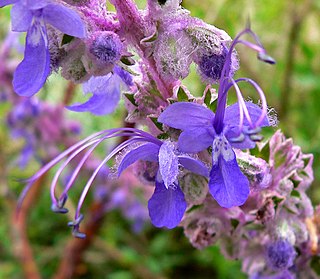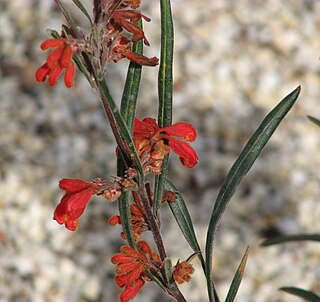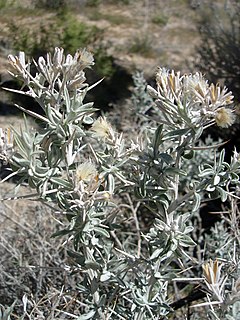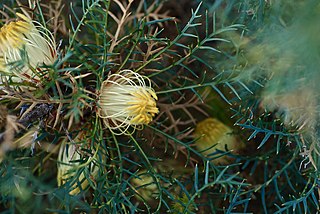
Trichostema lanatum, the woolly bluecurls, is a small evergreen shrub or sub-shrub native to arid coastal chaparral regions of California and the northern parts of Baja California.

Banksia baueri, commonly known as the woolly banksia, is a species of shrub that is endemic to the southwest of Western Australia. It has serrated leaves and a distinctively large and hairy looking inflorescence with cream, yellow or brown flowers, and hairy fruit.

Banksia meisneri, commonly known as Meisner's banksia, is a shrub that is endemic to a small area in the south-west of Western Australia. It has crowded, more or less linear leaves and in winter and spring, spikes of golden brown flowers followed by furry fruit which usually only open after fire.

Banksia heliantha, commonly known as oak-leaved dryandra, is a species of shrub that is endemic to Western Australia. It has hairy stems, serrated, egg-shaped to wedge-shaped leaves, golden yellow flowers and partly woolly follicles.

Grevillea caleyi, also known as Caley's grevillea, is a species of flowering plant in the family Proteaceae and is endemic to a restricted area of New South Wales. It is an open, spreading shrub with deeply divided leaves with linear lobes, and fawn flowers with a maroon to red style.

Grevillea arenaria, commonly known as sand grevillea or hoary grevillea, is a species of flowering plant in the family Proteaceae and is endemic to New South Wales. It is a spreading shrub with elliptic to egg-shaped leaves with the narrower end towards the base, and red, pink or orange flowers.

Grevillea bronweniae is a species of flowering plant in the family Proteaceae and is endemic to the south-west of Western Australia. It is an erect shrub usually with more or less linear leaves, and wheel-like clusters of crimson flowers.

Grevillea argyrophylla, the silvery-leaved grevillea, is a species of flowering plant in the family Proteaceae and is endemic to the south-west of Western Australia. It is an erect, sometimes low-lying shrub with egg-shaped leaves with the narrower end towards the base, and white flowers, sometimes tinged with pink.
Eriastrum virgatum is a species of flowering plant in the phlox family known by the common name wand woollystar. It is endemic to California, where it is known the coastline and coastal mountain ranges of Monterey and San Benito Counties. It grows in chaparral and coastal and inland scrub habitat. It is an annual herb producing a thin, usually woolly stem up to about 40 centimeters tall. The leaves are narrow and thick, up to 5 centimeters long, and sometimes divided into two narrow lobes. The inflorescence is a woolly cluster of narrow, leaflike bracts laced with webby fibers. The flowers have yellow throats and bright blue corollas with lobes up to a centimeter long.

Constancea is a monotypic genus of flowering plants in the aster family containing the single species Constancea nevinii, which is known by the common name Nevin's woolly sunflower. It is endemic to three of the Channel Islands of California, where it grows in coastal scrub habitat. This is a small shrub or subshrub generally growing up to one or 1.5 meters tall, and taller when an erect form, with a branching, woolly stem. The whitish, woolly oval leaves may be up to 20 centimeters long and are divided into many narrow lobes with edges curled under. The inflorescence is a cluster of 10 to 50 or more small flower heads, each on a short peduncle. The flower head has a center of hairy, glandular, star-shaped yellow disc florets and a fringe of four to nine yellow ray florets, each about 2 millimeters long. The fruit is an achene a few millimeters long with a small pappus at the tip.

Grevillea acrobotrya is a species of flowering plant in the family Proteaceae and is endemic to the southwest of Western Australia. It is a prickly, spreading to erect shrub with egg-shaped to trowel-shaped leaves with sharply-tipped lobes, and white to cream-coloured flowers with smaller leaves at the base.

Stenocarpus cryptocarpus, commonly known as the giant-leaved stenocarpus, is a species of flowering plant in the family Proteaceae and is endemic to north Queensland. It is a tree with buttress roots at the base, simple, mostly elliptical adult leaves, groups of cream-coloured flowers and narrow oblong follicles.

Tetradymia stenolepis is a species of flowering plant in the aster family known by the common name Mojave cottonthorn. It is native to the deserts around the intersection of Arizona, Nevada, and eastern California, where it grows in woodland and scrub habitat on sandy and gravelly substrates. It is a bushy shrub with many branches coated in woolly white fibers and growing to a maximum height just over a meter. The narrow leaves are 2 or 3 centimeters long and harden into straight, sharp spines. Clusters of woolly leaves grow near the spines. The inflorescence bears up to 7 flower heads which are each enveloped in four or five woolly phyllaries. Each head contains up to four or five tubular yellow flowers each around a centimeter long. The fruit is a hairy achene which may be nearly 2 centimeters long, including its pappus of long bristles.
Tetradymia tetrameres is a species of flowering plant in the aster family known by the common name fourpart horsebrush and dune horsebrush. It is native to the Great Basin, where it occurs in western Nevada and just over the border in Mono County, California. It is a plant of dry scrub and sand dunes. It is a bushy, woolly shrub with many erect, spineless branches. It is the largest of the horsebrushes, growing up to two meters in height. The soft, woolly leaves are narrow and threadlike, growing up to 4 centimeters long. Shorter leaves occur in clusters around the primary leaves. The inflorescence bears 4 to 6 flower heads which are each enveloped in four or five woolly phyllaries. Each head contains up to four or five light yellow flowers each around a centimeter long. The fruit is a hairy achene which may be up to a centimeter long, including its pappus of long bristles.

Grevillea aspera, commonly known as the rough grevillea, is a species of flowering plant in the family Proteaceae and is endemic to Australia, occurring mainly in South Australia. It is low, spreading to erect shrub with oblong to egg-shaped leaves with the narrower end towards the base, and pinkish to red and cream-coloured, green, yellow or white flowers.

Grevillea brachystylis, also known as short-styled grevillea, is a species of flowering plant in the family Proteaceae and is endemic to the south-west of Western Australia. It is a low, spreading to erect shrub with linear to narrow egg-shaped leaves with the narrow end towards the base, and wheel-like clusters of hairy red flowers.

Grevillea commutata is a species of flowering plant in the family Proteaceae and is endemic to the west of Western Australia. It is a spreading, open to dense shrub with egg-shaped leaves with the narrower end towards the base, and white, cream-coloured, and pinkish-green flowers.

Leucospermum harpagonatum is an evergreen trailing shrublet with leathery, line-shaped, upright leaves and small heads with eight to ten cream, later carmine-colored, strongly incurved flowers assigned to the family Proteaceae. It is reminiscent of the hottentot fig without its flowers. It is called McGregor pincushion in English and flowers from late August till early November. It is critically endangered and occurs only in a very small area in the Western Cape province, South Africa.
Leucospermum fulgens is an evergreen, upright shrub of up to 3 m (10 ft) high, from the family Proteaceae. It has hairless and leathery inverted lance-shaped to oblong leaves tipped with mostly three teeth and globe- to egg-shaped flowerheads of 6–8 cm in diameter, that consist of pink to orange, later crimson flowers. From the center of the flowers emerge almost straight styles that jointly give the impression of a pincushion. It is called Potberg pincushion in English. New pink to orange flower heads occur between August and November, but older, crimson heads may persist until January. It is a critically endangered species, only known from one location in the Western Cape province of South Africa.

Banksia recurvistylis is a species of shrub that is endemic to a restricted area of Western Australia. It has densely crowded, deeply serrated pinnate leaves, the lobes very narrow triangular, and heads of between twenty-five and forty pale yellow flowers.

















